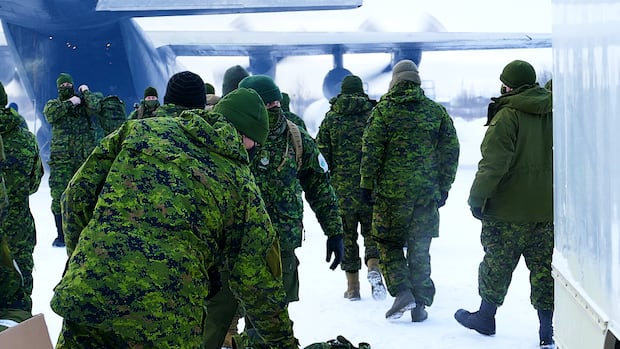Top general says military relationship with U.S. is solid as Trump's threats continue
Armed Forces see recruitment requests rising, but too early to say why
The country's top military commander delivered a keep calm and carry on message on Wednesday in the face of U.S. President Donald Trump's repeated threats to annex Canada.
Gen. Jennie Carignan says the military-to-military relationship between the two countries is solid and has not shown the signs of the political strain that has racked the two nations.
"The relationship that we have with our American military colleagues is very stable and very strong," Carignan said as the Department of National Defence released an update on how the military will rebuild its recruiting system.
Trump has been critical of Canada's level of defence spending and its inability — up until late unwillingness — to hit the NATO two per cent of gross domestic product target. He complained Canada relies on the United States to defend it, claiming the country is not viable and would welcome annexation.
Carignan said this is not something that has entered the conversation with her American counterparts.
"Militarily, we're not there at all," she said, while pointing to the level to which the two nations rely on each other through the continental air defence command, NORAD.
Another senior defence official noted there's been a steady increase in the number of Canadians volunteering to join the military, but Commodore Pascal Belhumeur, who is running the branch in charge of recruiting, said they're not able to specifically attribute the rise to the political tension and surge in patriotism.
"So far we're not tracking anyone who's coming in saying that that's the reason," Belhumeur said.
He said the military's prospect surveys will provide insight into whether there is a shift in why more people are enlisting.
Andrew Latham, professor of international relations at Macalester College in St. Paul, Minn., said there is an opportunity for the Canadian military to solve their recruiting woes, but it remains to be seen whether they'll take it.
"I would just try to build on this renewed sense of Canadian nationalism … and a very old sense that military service is virtuous," Latham said. "It's not something that you just do to make a few bucks here and there. It's something you do because it's the right thing to do. So they could use this. What Trump saying is to their advantage to try and recruit more people."
Defence Minister Bill Blair said there's no doubt Trump's comments have awakened a new sense of purpose in Canadians, but whether it means they're going to beat path to the recruiting office remains to be seen.
"I'm hoping that we'll encourage Canadians in every part of the country to consider serving their country in the Canadian Armed Forces. My job is to make sure that we can bring them in, in a timely way," said Blair.
And that is the challenge.
The Armed Forces are climbing out of a pretty big recruitment hole, partly created by the effects of the pandemic and partly the result of the reputational hit of the sexual misconduct scandal that affected a number of former senior leaders.
The number of full-time — or regular force — members is currently hovering around 65,000, according to a chart released Wednesday. That's roughly 6,500 members short of the military's authorized full-time strength, which was set in the Liberal government's old 2017 defence policy.
The Defence Department has struggled to hit its recruiting goals and when combined with the number of people deciding to return to civilian life, the military has seen a growing shortage of personnel that Defence Minister Bill Blair referred to last year as a potential "death spiral."
Throughout the military there are acute shortages in various trades, most especially in the navy.
The military has blamed its inability to hit its recruiting targets on an outdated, glacial system of enrolment that has literally seen tens of thousands of volunteers waiting months for an answer.
Senior military officials, led by Carignan, walked journalists through the series of changes that are being made, including a revised security clearance system for permanent residents who want to join, a streamlined online application process and an expanded basic training system.
Meeting authorized capacity still years away
Even still — and despite rising global tension and political uncertainty surrounding the Canada-U.S. relationship — the military is not expected to reach its current authorized strength until April 2029.
"This is the goal that we have internally," Carignan said, "so that we can start building additional personnel on that. But if we can do it faster, we'll do it."
Lt.-Gen. Lise Bourgon, chief of military personnel, said she feels the pressure.
Carignan, she said, gave her "a very clear order" to reach the goal. "But if everything goes well, we'll reach that."
Prior to retiring as chief of the defence staff last year, former general Wayne Eyre warned in an interview with CBC News that the recruiting hole the military was climbing out of was much deeper than most realized. That's because the Liberal government has ordered new equipment, such as F-35 fighters, and it plans to buy submarines.
The new capabilities, Eyre said, will require more personnel.
The new target for the size of the regular force military is 85,500 — a goal the Defence Department doesn't plan to hit until 2042.
With files from Ashley Burke




